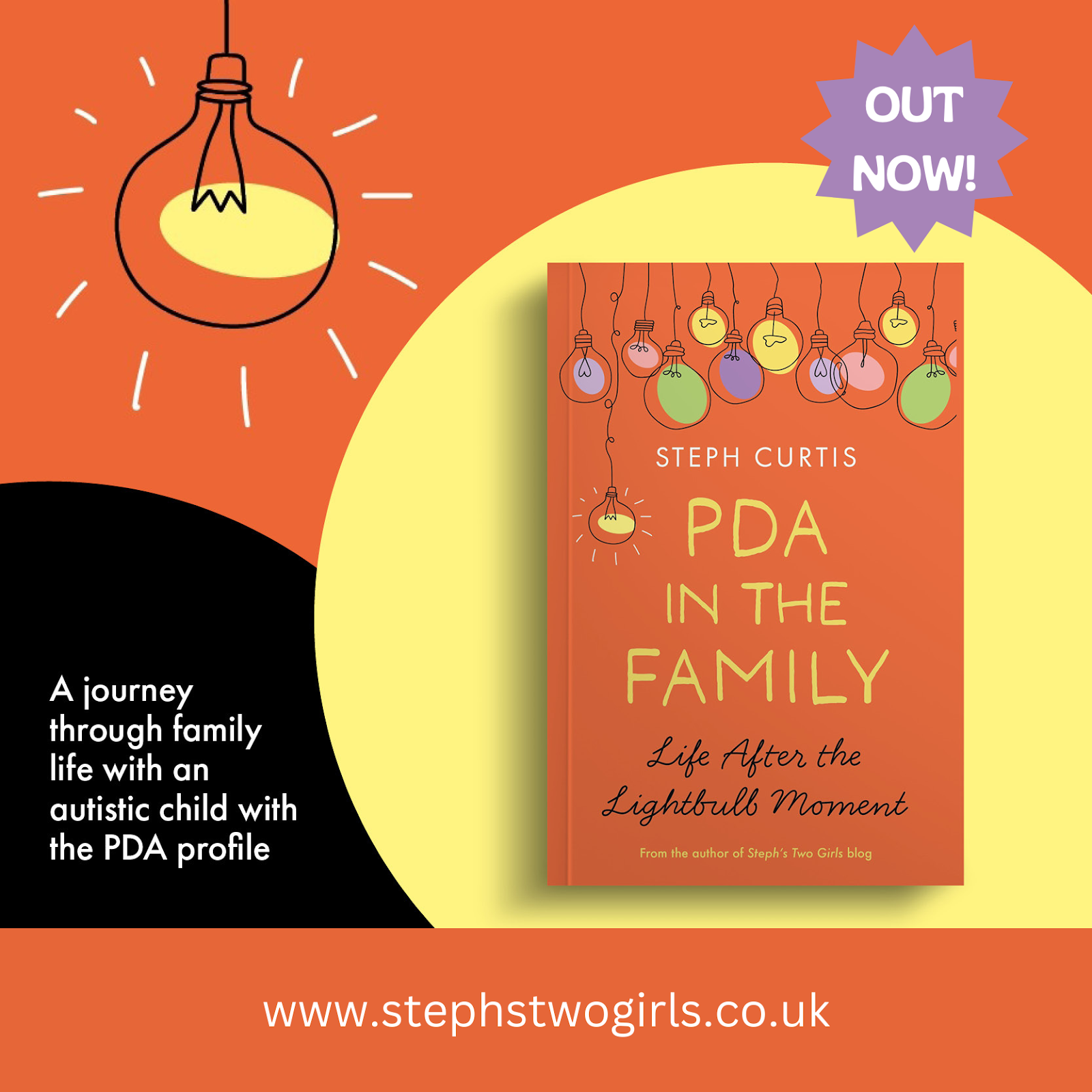When I read the book Understanding Pathological Demand Avoidance Syndrome in Children for the first time, I had emotional tears in my eyes. I wondered how the authors had managed to write as if they had been in our house, watching our younger daughter and her reactions to life. As soon as I finished reading it, I wanted everyone else I knew to read about it so that they would understand our daughter better. I blogged about this 'lightbulb moment' in a post titled 'Pathological Demand Avoidance = my daughter; and a challenge for all..' - the challenge was to read the book. I even remember taking a copy into the mainstream infant school my daughter was attending at the time; I don't know why I thought any of the teachers would have time to read it but I didn't stop to think about that. I was so excited and eager to help others understand our daughter. Over the past ten years I have suggested this book to many others and it is still the first one I recommend to give a comprehensive overview of PDA.
Although this book has always topped my main blog post reviewing a large number of published books about PDA, I only recently realised that I haven't ever written a separate review post for it. So now is the time!
Understanding Pathological Demand Avoidance Syndrome in Children was published over 11 years ago and was written by a team of four - Phil Christie, a consultant child psychologist who worked with Professor Elizabeth Newson (a British Developmental Psychologist who first proposed the term PDA in the 1980s), Margaret Duncan, GP and parent to a PDA child, Ruth Fidler, now education consultant and previously Assistant Head Teacher at a school for autistic pupils, and Zara Healy, journalist and parent to a PDA child. Parents and carers who belonged to the PDA Contact Group forum (the forerunner of the PDA Society) and classroom staff also shared their experiences and stories with the authors.
There are 194 pages in the book and six main chapters: What is PDA?, Positive Everyday Strategies, Living with PDA, Providing the Best Education for a Child with PDA, Developing Emotional Well-being and Self-awareness in Children with PDA, and Summing Up and Questions for the Future.
The first chapter covers a brief history of Professor Newson's original work and studies on PDA, followed by criteria for diagnosis and the key features of PDA as they were noted at the time this book was written. The key features section goes into detail and shares examples of behaviours, or actions and language that might point towards PDA. The chapter ends with some thoughts on overlap, co-morbidity and mis-diagnosis, followed by a look at the PDA child as a learner.
There was a quote from a parent within this first chapter that resonated strongly with me and I'm sure it will for many others:
The paediatrician did place Daniel on the autistic spectrum, but it didn’t quite fit – if the hole is big enough, the square peg will fit. We accepted this, but then we came across the diagnostic criteria for PDA, and this fitted Daniel perfectly.
Chapter 2 offers suggestions for how education staff could encourage and support PDA learners in schools and a key point noted here is how the strategies generally recommended for autistic children at that point in time did not seem to be so successful for PDA children. Chapter 3 covers the impact of PDA at home. Ways to manage demands, meltdowns and relationships with both siblings and professionals are discussed, with many 'real-life' experiences from families offering real insight. One quote that jumped out here was the following:
..you get used to bending over backwards with everything and walking on eggshells. Basically, you can’t relax and can never assume things are going to be okay. Something that’s good one day can be a disaster the next. If you look at isolated moments it could read that your child doesn’t have a problem, but if you look at the ground work, preparation, quick-thinking, and shoring up that has to happen to make something at least have a chance of going OK, then you're seeing the real picture. It’s so easy to forget all that because you do it without thinking.
Chapter 4 provides an in-depth look at how education does and doesn't work for PDA children and chapter 5 explores ideas of how to encourage emotional understanding and self-awareness, predominantly from a school's point of view - but this can also be helpful for families. Staff in one school were asked what advice they would give to those who are new to working with children with PDA, and they said:
- Remember that less is usually more.
- Reflect on your own input and impact regularly.
- Understand that handing over the balance of power to the child is often the best way to achieve better outcomes for everyone.
- Be nonjudgemental, flexible, clear enough, to be fair, but unpredictable enough to be interesting.
- Don’t be afraid to admit if you are struggling to manage the child – use the support and experience of other staff.
- Prioritise building and maintaining a positive relationship, be prepared to reduce your expectations and take nothing personally.
- Be prepared to start afresh as often as is necessary.
The final chapter takes a look at research that was in the pipeline back then, and a brief mention of PDA children moving into adulthood.
As mentioned early on in my post, this book was published several years ago. Some of the thinking around PDA may have moved on slightly since then, but I still feel it contains lots of useful information. There are several examples of situations we have faced and strategies that may help, both at home and at school.
I recommend keeping an eye on the PDA Society website for all the up-to-date research and information regarding PDA - sign up to receive news and updates here: www.pdasociety.org.uk/get-involved/newsletters-landing/
To purchase a copy of this book, tap/click on this title or the image below Understanding Pathological Demand Avoidance Syndrome in Children.
Ruth Fidler and Phil Christie co-authored another book about PDA a few years later and that was published in 2019 - Collaborative Approaches to Learning for Pupils with PDA. I also highly recommend this one for educators, and I've included a brief review of it in my post More Books About Pathological Demand Avoidance.
For a longer list of published books about PDA, please see my post Books about the Pathological Demand Avoidance (PDA) profile of autism.
*This post contains affiliate links and I may receive a small commission if you visit a link and buy something. It won't cost you any extra*























One fairly big change - Jessica Kingsley Publishing is now distributed and published by Hachette - so they are more easily accedssed.
ReplyDeleteAdelaide Dupont
Thank you, that's good news! Especially for my upcoming book :)
DeleteIt's heartwarming to hear how deeply this book touched you and resonated with your experiences. Your passion for sharing knowledge about Pathological Demand Avoidance Syndrome is evident, Your review provides a compelling overview of the book's content, making it even more compelling for others to consider reading and understanding PDA better. Thank you for your dedication to raising awareness and supporting families dealing with this condition.
ReplyDeleteThank you for your kind comment!
Delete